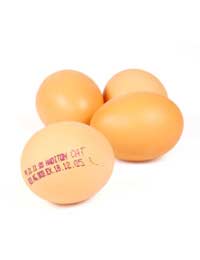
According to WRAP, a third of all the food we buy in the UK is thrown in the bin. It’s not just because it’s left on our plates – that regular fridge clear-out often involves chucking away things that ‘just looked a bit funny’.
What can we do about this wastage? To minimise waste it’s important to understand storage techniques and rules. We’ve shown you lots of ways to store or use up vegetables and fruit; now we turn to fresh and cupboard produce. Understanding information labels will help prevent wasting fresh meat, eggs, and baking goods. Here’s our useful guide.
‘Use By’
The ‘Use By’ date is displayed on foods like fresh meat and fish, milk and pre-packed salad. It’s been determined by the manufacturer, who is responsible for testing foods in the factory. They first determine a date when the bacteria multiplies to a harmful level. Then a safety-barrier is worked in, so the ‘Use-by’ date is on the cautious side. However, the Food Standards Agency upholds them strictly: it says “Don’t use any food or drink after the end of the ‘Use by’ date on the label, even if it looks and smells fine.”
If you freeze fresh produce (preferably as soon as you buy it, but never later than the Use by date), you can extend its shelf life – check the packaging for advice. Most frozen items need to be thawed thoroughly in the fridge before cooking, although the packaging of some advises you to cook from frozen.
‘Best Before’
The ’Best Before’ date appears for your guidance. This information is designed to ensure that you enjoy the food item at its best; post-date consumption will mean the food item is chewier, softer, or more deteriorated than it once was! Knowing this, you could try a crunch of that dubious cereal in the cupboard, or open a tin of beans a week after their Best-Before date. The exception to this rule is fresh eggs. Although labelled with a ‘Best Before’ date, eggs can contain harmful bacteria that multiplies over time. You shouldn’t risk eggs after the printed date, however hungry you may be!
In summer 2008, a Daily Mail journalist carried out an experiment – two weeks living on foods past their Best-Before and Use-by dates. He emerged unharmed and perfectly healthy, having eaten mouldy green toast, 3-day-old steak pie, and grey mince. Some critics believe that supermarkets set their Best before and Use By dates well behind the actual dates at which the food items would cause a health concern. This has two advantages: it safeguards the supermarket from customer lawsuits, but it also means that we throw out more food more often – sending us straight back for another trolley-load.
Proper Storage and Preparation
Follow the storage instructions on the food packaging, or the Use-by date will be made redundant. If a bottle of salad dressing instructs you to ‘use within a week of opening’, you need to open it a week before the Use-by date!
Uncooked food is far more dangerous than properly-cooked food, and you must take care to follow the rules of food hygiene, too. Wash your hands before beginning food preparation. After preparing raw meat or fish, put the utensils you used directly into the sink or dishwasher to avoid them contaminating fresh or raw parts of your meal.
